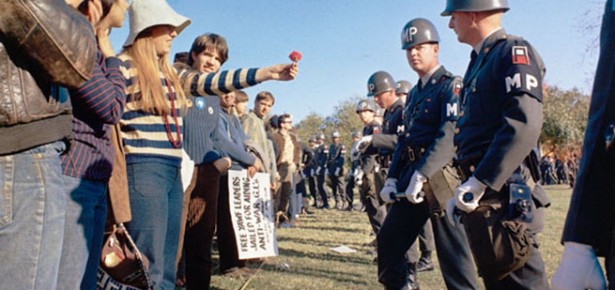
S.Sgt. Albert R. Simpson, US National Archives
In 1967 thousands of counterculture hippies flocked to San Francisco’s Haight-Ashbury District to celebrate the Summer of Love. The large numbers jarred mainstream society. All summer hippies listened to rock music, took psychedelic drugs, primarily LSD, and indulged in casual sex. This mass movement had started in January 1967, when counterculture leaders had planned and carried out the first Human Be-In in San Francisco.
In January 1967 Allen Cohen , Ron Thelin, Allen Ginsberg, and others promoted the Human Be-In in Golden Gate Park. Seeking to bridge radicals and hippies, Cohen called for “a union of love and activism.” The idea was to impress authorities by attracting large numbers of young people to a big party with plentiful shared food , alcohol, and drugs , including marijuana and LSD , along with free rock music and poetry readings. “Human Be-In ” was a play on human being, but it also meant that it was acceptable just to exist in the present. Shortly afterward, Richard Alpert announced the philosophy of “Be Here Now.” Calling for a “Pow-Wow” and “A Gathering of the Tribes,” the Be-In poster featured an Indian on a horse. To hippies, Indians were pure in spirit, primitives liberated from Western civilization , and true Americans. As part of the search for authenticity , the counterculture tried to gain depth by absorbing others’ wisdom. On the poster the Native American carried an electric guitar, but it was not plugged in.
The crowd was estimated at around twenty thousand. The Beat poet Gary Snyder officially opened the event by blowing on a conch shell, and Ginsberg chanted “om,” which he had learned in India. Timothy Leary attended. Wearing white clothes with a flower in his ear, the stoned psychologist famously advised: “Tune in, turn on, drop out.” Leary later explained that he wanted young Americans to tune into their feelings, get turned on by the music, and then drop out of the middle-class rat race, but most people at the Be-In thought Leary meant that they should take acid that day. Owsley Stanley passed out acid.
A good deal of LSD was consumed, and the Dead, the Airplane, and other bands played loud and long. When the political radical Jerry Rubin tried to give a speech, the crowd ignored it. Rubin’s angry tone scared Garcia, who asked, “Why enter this closed society and make an effort to liberalize it? Why not just leave it and go someplace else?” Hell’s Angels protected the sound system. “We had no idea there were so many of us,” one attendee later said.
The success of the Be-In led to an interesting philosophical discussion about the meaning of what was happening among Snyder, Ginsberg, Leary, and Alan Watts on Watts’s houseboat in nearby Sausalito. The “houseboat summit ” was recorded, and Allen Cohenprinted the transcript in the Oracle. Ginsberg believed that the Be-Invalidated the Beat search for individual happiness and demonstrated a widespread following among the emergent hippies. He saw value in drugs, music, and community in the search for spirituality, but after his 1963 spiritual epiphany, he no longer emphasized drugs. Snyder , heavily influenced by his eleven years in the Zen Buddhist monastery in Japan, stressed the spiritual significance of the moment, and Alan Watts, the student of Eastern religions who had settled in the Bay Area, concurred. In contrast, Leary believed that LSD would change the world one stoned mind at a time. “I want no part of mass movements,” he declared. “I think this is the error that the leftist activists are making.” The high priest of acid sought spiritual enlightenment through drug-induced psychological transformation.
Download the full excerpt from American Hippies here.
Latest Comments
Have your say!